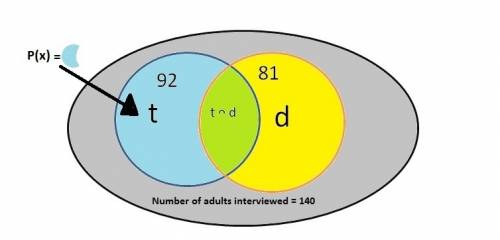27.7%
Step-by-step explanation:
Let's call:
n: the number of adults interviewed
t: number of adults who watch tennis
d: number of adults who practice some sport
x: number of adults who watch tennis and do not practice a sport
The probability that a randomly chosen adult watches tennis and does not play any sports is calculated as follows:
- We calculate the probability that a selected adult will see tennis.
P(t) = 92/140 = 0.657
- We calculate the probability that an adult plays a sport:
P(d) = 81/140 = 0.5786
- We calculate the probability that an adult will see tennis and play some sport (See diagram attached)
P (t ∩ d) = 0.657 (0.5786) = 0.3802
Finally the probability that an adult who sees tennis does not play any sport is:
P(x) = P(t) - P(t ∩ d) = 0.657 - 0.3802
P(x) = 0.277
